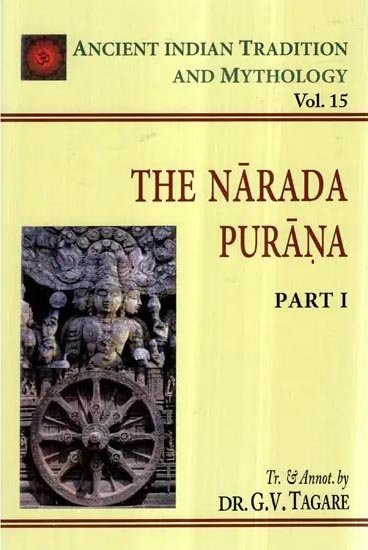Narada Purana (English translation)
by G. V. Tagare | 1950 | 14,468 words | ISBN-10: 8120803477 | ISBN-13: 9788120803473
This page describes 1.6. The Purana in Modern Indian Languages of the English translation of the Narada Purana—an ancient Sanskrit text within Hindu literature categorized as one of the eighteen Mahapuranas. It explores various aspects of cosmology, ethics, and rituals, compiling rich narratives that emphasize devotion to Vishnu and the concepts of Dharma (righteousness) and Bhakti (devotion). The Narada Purana also addresses Tantric practices, philosophical discourses on Yoga and self-realization.
Go directly to: Footnotes.
1.6. The Purāṇa in Modern Indian Languages
[Full title: The Nāradīya Purāṇa and its place in the evolution of the Purāṇa literature: (6). The Purāṇa in Modern Indian Languages]
As a matter of fact, there was an unbounded and unrestrained scope for the Purāṇas to expand. Indians being a mixed people synthesized their traditional Aryan, Dravidian, Austric and Mongoloid beliefs, folk-lore, dogmas and rituals into Purāṇas. And when Sanskrit ceased to be understood by the masses, they wrote Purāṇas in modern Indian languages, e.g. the Mānasa Purāṇa in Assamese and Bengali, the Ḍāṅgavai Purāṇa in Marathi, the Śaivite Periya-Purāṇam in Tamil.[1]
To sum up:
1. There was a collection of ancient legends or an Ur-Purāṇa at the time of the Atharva Veda and the credit of its being the arranger (Vyāsa) is given to Kṛṣṇa Dvaipāyana (Circa 950 B.C.).
2. The Ur-Purāṇa developed into four Mūla or Ādi Purāṇas by Circa 850 b.c.
3. By the time of Āpastamba (C. 500 b.c.) Purāṇas having names like Bhaviṣyat existed and in addition to the usual characteristics like Sarga, Pratisarga, matters pertaining to Dharma Śāstra were found in them.
4. By the time of Kauṭalīya Arthaśāstra (C. 300 b.c.) the Paurāṇika Sūta came to be substituted by an officer of the state with the Purāṇa portfolio. Dr. Kane presumes that those Purāṇas were similar in characteristics with the extant ones.
5. The Mūla Purāṇas seem to have survived till the time of the Viṣṇu Purāṇa (100-300 a.d.). The Viṣṇu Purāṇa retained the Pañcalakṣaṇa structure in tact.
6. As the Purāṇas were associated with Pañca-lakṣaṇas for about 5 or 6 centuries, even the Purāṇa authors who did not conform to that structure, have incorporated the Pañca-lakṣaṇa definition of Purāṇa in their own works—a fact recorded by Amara Siṃha (5th cent, a.d.) in his Sanskrit lexicon (Amara Kośa).
7. Purāṇas went on developing and incorporating copious material on Dharmaśāstra and some from other branches of knowledge in encyclopaedic Purāṇas like the Nārada, Garuḍa and Agni. But the mediaeval writers on Dharma Śāstra treated them like Smṛtis and quoted them as authorities on matters pertaining to Dharma (such as Vrata, Tīrtha, Prāyaścitta, Varṇāśrama-dharma and others).
8. The tendency of Purāṇa writing continued even in Modern Indian languages.
The Nāradīya or Nārada Purāṇa however, belongs to the Sanskrit stage. Hence, we consider it as per pañca-lakṣaṇa criterion of Mahāpurāṇas.
Footnotes and references:
[1]:
vide S. K. Chatterji—Purāṇa Apocrypha Select Writings, pp. 121-138.
